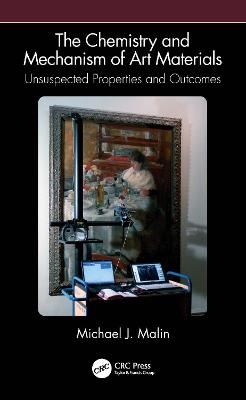
The Chemistry and Mechanism of Art Materials
CRC Press (Verlag)
978-0-367-51345-0 (ISBN)
This unique book presents an integrated approach to the chemistry of art materials, exploring the many chemical processes involved. The Chemistry and Mechanism of Art Materials: Unsuspected Properties and Outcomes engages readers with historical vignettes detailing examples of unexpected outcomes due to materials used by known artists.
The book discusses artists’ materials focusing on relevant chemical mechanisms which underlie the synthesis and deterioration of inorganic pigments in paintings, the ageing of the binder in oil paintings, and sulfation of wall paintings as well as the toxicology of these pigments and solvents used by artists. Mechanisms illustrate the stepwise structural transformation of a variety of art materials.
Based on the author’s years of experience teaching college chemistry, the approach is descriptive and non-mathematical throughout. An introductory section includes a review of basic concepts and provides concise descriptions of analytical methods used in contemporary art conservation.
Additional features include:
Illustrations of chemical reactivity associated with art materials
Includes a review of chemical bonding principles, redox and mechanism writing
Covers analytical techniques used by art conservation scientists
Accessible for readers with a limited science background
Provides numerous references for readers seeking additional information
Michael Malin received a BS from City College of New York and a Ph.D. from Rutgers (Biochemistry). This was followed by postdoctorals at Rutgers (Organic) and then Brandeis (Bio-organic). He taught chemistry at Western Connecticut State College/University (16 years) and at Sarah Lawrence College (2 years). He covered courses in general, organic and biochemistry. At SLC, he taught a course in the chemistry of art materials, and this book came out of that experience. When not teaching, he was employed by Technicon Instruments Corporation/Bayer Diagnostics for 23 years. His role was generally to solve stability problems related to both liquid reagent formulations and machine parts in the development of automated blood analyzers. The scope of these problems varied widely; from the instability of a photo-polymerizable acrylic adhesive to the erosion of alumina shear valves. When he left industry, he resumed thinking about art materials, and found common chemical/mechanistic themes relating to stability problems. Eventually, this book was the result. His hobbies include: international travel, playing double bass in jazz groups, salsa dancing and cycling.
Chapter 1 Essential Concepts
Chemical Bonding, Solubility, Properties of Solids,
Hard and Soft Acids and Bases
Oxidation-Reduction
Chemical Reaction Mechanisms
Experimental Methods Used to Characterize Works of Art
Chapter 2 Preparation of Inorganic Pigments
Introduction
Black Pigments
Antimony Black
Carbon Blacks
Cobalt Black
Iron Oxide, Magnetite
Manganese Black
Blue Pigments
Azurite
Cerulean Blue
Egyptian Blue
Prussian Blue
Smalt
Ultramarine
Verdigris
Brown Pigments
Iron (III) Oxide Pigments
Lead Dioxide
Green Pigments
Chromium Oxide
Hydrated Chromium Oxide, Viridian
Malachite, see Azurite
Paris Green
Verdigris
Red Pigments
α-Cinnabar and Vermilion
Red Lead
Iron (III) Oxide, Hematite
α-Realgar, see Orpiment
Violet Pigments
Pigment Violet 14
White Pigments
Antimony White
Barium White
Lithopone
Titanium White
White Lead
Zinc White
Zinc Sulfide
Yellow Pigments
Bismuth Vanadate
Cadmium Pigments
Cobalt Yellow
Iron (III) Oxide
Lead Chromate
Lead Tin Yellow type I
Lead Tin Yellow type II
Lead Monoxide, Litharge and Massicot
Lead Tin Antimonate, Naples Yellow
Orpiment
Titanium Yellow
Chapter 3 Silica, Silicates and Aluminosilicates
Introduction
Silica
Silicates
Pigment-Silicate Interactions
Pottery Glazes
Aluminosilicates
Chapter 4 Discoloration Stories
Introduction
Smalt
Red Lead
Realgar
Cinnabar
Hematite
Chrome Yellow
Silverpoint
Cadmium Yellow
Blackening of Pigments by H2S
Ultramarine
Azurite and Malachite
Medieval Pigments
Chapter 5 Toxicology of Art Materials
Introduction
Organics
Methylene Chloride
Carbon Tetrachloride
Trichloroethylene
n-Hexane
N-Methylpyrrolidone
Diisocyanates
Alcohols, Glycols and Glycol Ethers
Mineral Spirits
Inorganics
Lead
Zinc, Cadmium and Mercury Familial Properties
Cadmium
Mercury
Silver
Arsenic
Chromium
Chapter 6 Ageing of Oil Paint
Oxidative Degradation of Oil Binder
Metal Soap formation
Chapter 7 Ageing of Wall Paintings
Secco and Fresco methods
Reversal of Sulfation
Deposition of Water Soluble Salts
Degradation of Oil Binder
| Erscheinungsdatum | 29.12.2021 |
|---|---|
| Zusatzinfo | 20 Tables, black and white; 11 Line drawings, color; 106 Line drawings, black and white; 26 Halftones, color; 1 Halftones, black and white; 37 Illustrations, color; 107 Illustrations, black and white |
| Verlagsort | London |
| Sprache | englisch |
| Maße | 156 x 234 mm |
| Gewicht | 349 g |
| Themenwelt | Kunst / Musik / Theater ► Kunstgeschichte / Kunststile |
| Reisen ► Reiseführer | |
| Geisteswissenschaften ► Geschichte ► Hilfswissenschaften | |
| Technik ► Maschinenbau | |
| ISBN-10 | 0-367-51345-5 / 0367513455 |
| ISBN-13 | 978-0-367-51345-0 / 9780367513450 |
| Zustand | Neuware |
| Informationen gemäß Produktsicherheitsverordnung (GPSR) | |
| Haben Sie eine Frage zum Produkt? |
aus dem Bereich


